
Frank Horton, Winston-Salem, North Carolina, ca. 1985. (Unless otherwise noted, all photographs are courtesy, Old Salem Museums & Gardens, and all objects illustrated are from the collections of the Museum of Early Southern Decorative Arts and Old Salem Museums & Gardens.)

Frank Horton with Luke Beckerdite, Winston-Salem, North Carolina, ca. 1979. The author had the privilege and pleasure of working with Frank at MESDA from 1979 to 1986.

Advertisement by Joe Kindig in Antiques 27, no. 4 (April 1935): 121. The black sugar jar on the bottom shelf of the cupboard is now in the collection of Old Salem Museums & Gardens
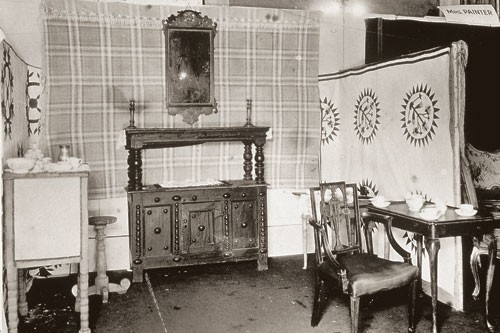
Mr. and Mrs. J. L. Brockwell’s booth at the Commodore Hotel, in New York City, 1929.
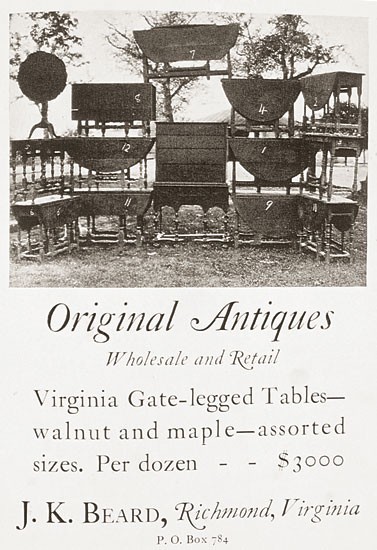
Advertisement by J. K. Beard in Antiques 4, no. 4 (October 1923): 193.

Cellaret illustrated on pl. 3, p. 72 in Paul H. Burroughs, Southern Antiques (Richmond, Va.: Garrett & Massie, 1931). This cellaret is now in the MESDA collection. It is attributed to an anonymous artisan who worked in the Roanoke River basin area of North Carolina and who marked several pieces with his initials “WH.”

Frank Horton and his mother, Theo Taliaferro, in front of their house in Old Salem, Winston-Salem, North Carolina, ca. 1965.

Clothes cupboard, southeastern Virginia, 1650–1690. Walnut with yellow pine. H. 61 1/2", W. 61 3/4", D. 20".

Bedstead, eastern North Carolina, 1720–1740. Walnut. H. 77", W.55 7/8", D. 76 1/2".
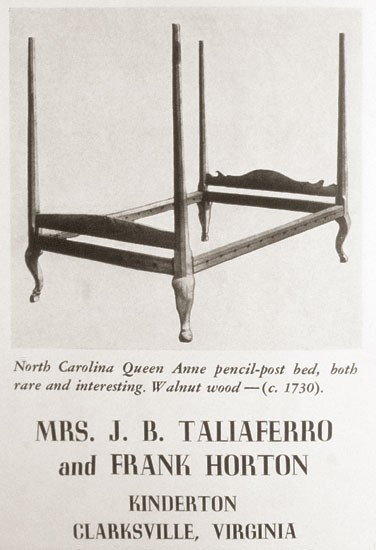
Advertisement by Mrs. J. B. Taliaferro and Frank Horton, Antiques 41, no. 3 (March 1942): 166.
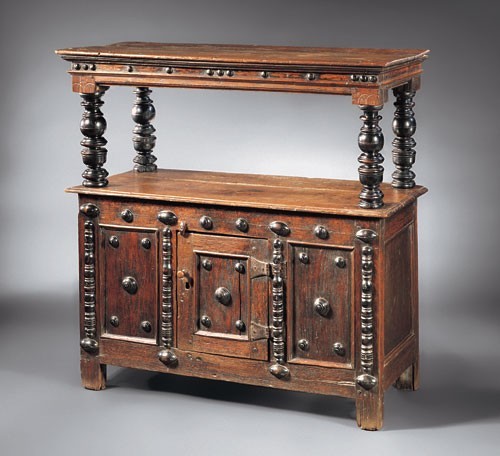
Court cupboard, southeastern Virginia, 1620–1680. Walnut with yellow pine. H. 49 7/8", W. 50", D. 18 7/8".

Early view of Main Street in Old Salem.

Frank Horton (far right) conferring with architects involved in restoration projects at Old Salem.

Frank Horton cataloging timbers from the Levering House, Salem, North Carolina, ca. 1971.

Frank Horton and Ada Allen examining the paint and masonry of the Gemeinhaus, Bethabara, North Carolina, ca. 1970.

Gemeinhaus, Bethabara, North Carolina, 1788.
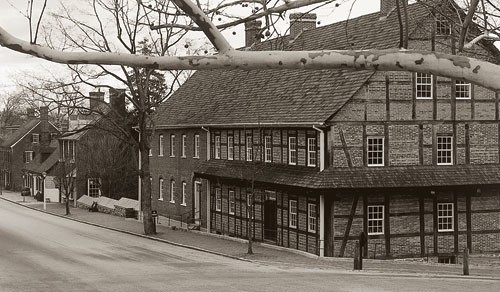
Single Brothers House, Salem, North Carolina, 1769. (Photo, Virginia Weiler.) The brick addition to the original half-timber structure was completed in 1786.

Frank working on the Moravian research files, 1966.

Dish attributed to Gottfried Aust, Salem, North Carolina, 1770–1780. Lead-glazed earthenware. Diam. 13 1/2". (Photo, Gavin Ashworth.) This dish is one of the most naturalistic and technically accomplished examples of American slipware. Dishes of this type were intended as decoration and often displayed on furniture and on mantels or architectural moldings.

Desk-and-bookcase attributed to Johannes Krause, ca. 1795. Cherry and cherry veneer with yellow pine and tulip poplar. H. 97 1/4", W. 46 1/4", D. 25 3/8".

John Valentine Haidt, The Queen of Sheba Visits King Solomon, 1765. Oil on canvas. 25" x 29".
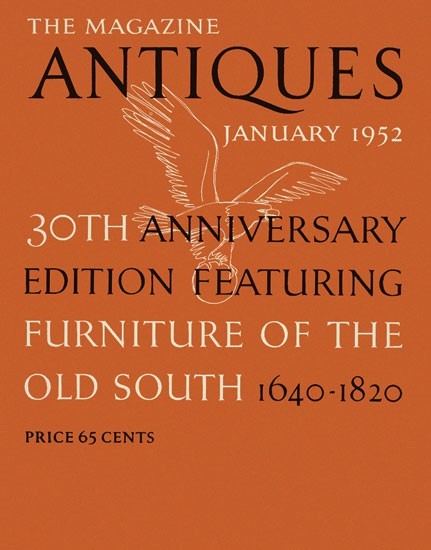
Cover of Antiques 61, no. 1 (January 1952).

Page 53 in E. Milby Burton’s article, “The Furniture of Charleston,” in Antiques 61, no. 1 (January 1952). The desk-and-bookcase is now in the MESDA collection (see fig. 24).

Desk-and-bookcase with carving attributed to Henry Burnett, Charleston, South Carolina, 1750–1755. Mahogany with cypress and mahogany. H. 97 3/4", W. 44 1/2", D. 24 1/4".

Early view of the Kroger grocery store that became MESDA.

Installation of the Chowan Room, MESDA.

Chowan Room, MESDA.
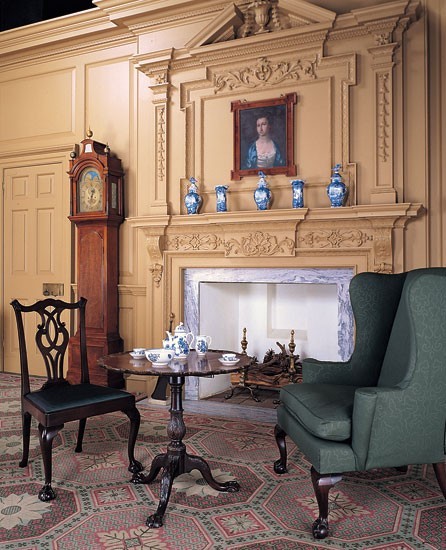
Room copied from the parlor of the Humphrey Summers House, Charleston, South Carolina, ca. 1770. MESDA staff member John Bivins oversaw the production of the millwork, replicated the carving with the assistance of the author, and designed the lighting, while Frank and other staff members consulted period inventories, newspapers, and advertisements to develop furnishing plans. The reproduction Wilton carpet is based on a description of one stolen in Charleston in 1784, as well as on similar carpets depicted in contemporary British paintings. This room is in the west wing, which was completed in 1986.

Metals gallery in the west wing of MESDA.

Horton Center, 924 South Main Street, Winston-Salem, North Carolina.
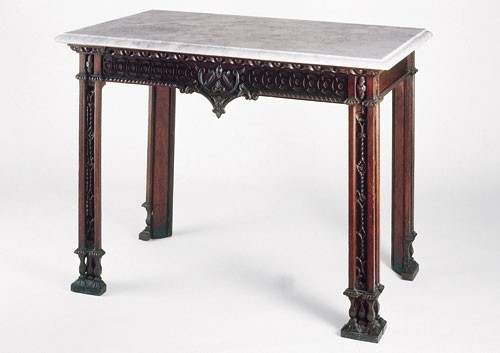
Sideboard table attributed to the shop of William Buckland with carving attributed to William Bernard Sears, Richmond County, Virginia, 1761–1771. Walnut and marble. H. 35", W. 42 1/2", D. 25 1/2". (Photo, Gavin Ashworth.) This table is one of two examples designed by Virginia and Maryland builder and architect William Buckland for John Tayloe II’s house, Mount Airy. Frank Horton sold a house in the historic district of Old Salem to raise the money to purchase this table for MESDA.

Couch, coastal South Carolina, 1700–1725. Walnut. H. 38 7/8", W. 27 1/4" (seat), L. 80 1/4". The upper portion of the crest is missing.

Henry Benbridge, unknown family portrait, Charleston, South Carolina, 1780–1790. 43 3/8" x 33 3/8". (Gift of Mr. and Mrs. Thomas Douglas III.)

Bureau-and-cabinet with carving attributed to Henry Burnett, Charleston, South Carolina, 1750–1755. Mahogany and mahogany veneer with cypress. H. 93 1/4", W. 35 1/8", D. 20 1/2". (Kaufman Americana Collection)

Research Room at MESDA.

Frank Horton recording information for the research files at MESDA

MESDA field representative Edith Culpepper Potter recording information on a painting.

Frank Horton and Brad Rauschenberg recording information on a piece of case furniture.

Frank Horton with one of his favorite station wagons, all of which had powerful engines but few other amenities.

Frank Horton sheltering his head from a hot summer sun.

Stuffed alligator with a MESDA card in its claw.

Elizabeth Boush, The Sacrifice of Isaac, worked at Elizabeth Gardner’s School, Norfolk, Virginia, 1768–1769. Silk tent stitch on silk. 19 1/2" x 11 1/2".

Library bookcase attributed to Martin Pfeninger, Charleston, South Carolina, 1770–1775. Mahogany, mahogany and burl walnut veneer, ivory, and unidentified marquetry woods with cypress. H. 128 3/4", W. 99", D. 20 1/2". (Courtesy, Charleston Museum; photo, Gavin Ashworth.)

Frank Horton providing instruction at the MESDA Summer Institute.
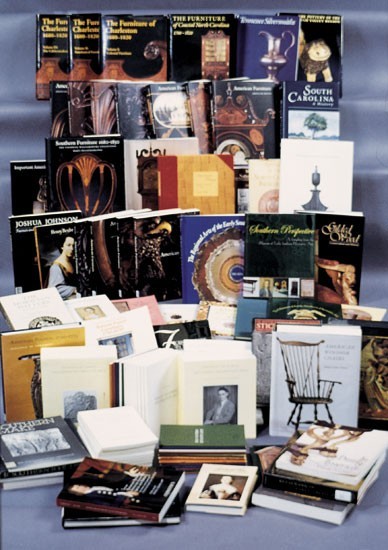
A selection of periodicals, journals, and books indebted to Frank Horton and the research files of MESDA.
This volume of American Furniture is dedicated to the memory of Frank L. Horton (1918–2004) (figs. 1, 2). Through his distinguished career as an antiques dealer, his pivotal role in the restoration of Old Salem, and his establishment of the Museum of Early Southern Decorative Arts—known today as MESDA—Frank came to personify the study of southern material culture. MESDA’s superb collection, vast research and photographic files, groundbreaking publications, and innovative educational programs are all the direct result of his generosity, vision, and dedication.[1]
To appreciate Frank’s contributions, one must understand the history of early southern decorative arts scholarship. Esther Singleton’s The Furniture of Our Forefathers (1900) was the first book to discuss furniture used in the South during the colonial and early federal periods. Although most of her research was based on period correspondence, inventories, and other documentary sources, she also illustrated several pieces of southern furniture and discussed the social and domestic contexts of similar forms. By the late 1920s, a handful of scholars—primarily dealers such as Joe Kindig Jr. of York, Pennsylvania, Mr. and Mrs. J. L. Brockwell of Petersburg, Virginia, and J. K. Beard of Richmond, Virginia—had come to realize that southern decorative arts were regionally distinctive. In the January 1935 issue of Antiques, Kindig published a seminal article on North Carolina earthenware and three months later advertised several examples of southern pottery (fig. 3). Much of the Moravian slipware that Frank Horton later purchased for Old Salem was discovered during Kindig’s frequent forays into the South.[2]
Unlike Kindig, who sold decorative arts from virtually every region of colonial America, Mr. and Mrs. J. L. Brockwell specialized in seventeenth- and early-eighteenth-century southern furniture (fig. 4). The Brockwells handled most of the seventeenth-century southern case pieces currently known, including court cupboards in the collections of MESDA and the Wadsworth Atheneum. Although it seems remarkable that anyone could specialize in such a rarefied field, early southern decorative arts were once much more available than they are today. In the October 1923 issue of Antiques, J. K. Beard advertised “Virginia Gate-legged Tables” for three thousand dollars per dozen (fig. 5). He claimed to carry only strictly straight American antiques—S. S. A. A.—and assured his patrons that none of the items in his shop “came from across the pond.”[3]
Early attributions such as these were usually based more on histories than on structural or stylistic details; however, early southern antiquarians understood that certain woods were indigenous to the South. Paul H. Burroughs devoted an entire chapter to woods in his book Southern Antiques (1931), the first monograph on southern furniture and one of the earliest regional studies (fig. 6). Since the publication of Irving W. Lyon’s Colonial Furniture of New England (1891), most of the books on American furniture had been large pictorial compendiums of objects from New England, New York, and Pennsylvania. Burroughs wanted to dispel the myth that southerners imported virtually all of their furnishings from Britain and set out to prove that “many craftsmen came to the southern colonies and produced work . . . comparable with the best made in [other areas of] America.”[4]
Like many of the great antiquarians of the twentieth century, Frank Horton began his career in the antiques trade. As a child, he frequently accompanied his mother, Theo Taliaferro (fig. 7), when she would go on buying trips near their home in Winston-Salem, North Carolina. Frank typically sat in the rumble seat of their car and looked for discarded Coke bottles along the roadside to help finance his stamp collection. During her career, Mrs. Taliaferro operated antiques shops in Winston-Salem, North Carolina, and the South Hill and Clarksville areas of Virginia. Frank initially tended shop at their business on Highway 1, just below South Hill, but soon developed the expertise to purchase objects for inventory and for his and his mother’s private collection, which would later become the cornerstone of MESDA.
Frank always endeavored to pay a fair price when purchasing objects from households. In 1992 he described an early antiquing trip on which he encountered an “old gentleman” sitting next to a “little corner table with Queen Anne pad feet” on the porch of a farmhouse:
I was very much carried away with [the table]. . . . So I asked [the old gentleman] . . . what he would take for it and he says, “You can just have it, son.” And I said, “No, sir, I ought to pay you something for it.” He said, “How about fifty cents.” I was a little in shock and I said, “All right.” So I bought it and loaded it in the car—and my conscience began to get the best of me. I knew I [should] . . . buy something from him that he knew the value of. . . . So we caught a chicken and he tied the feet up and I . . . paid him his price for it and drove off. I got down the road and turned the chicken loose. I don’t know what he thought when that chicken came running back down . . . [the dirt road]. But anyway, I sold the table the same day. Wish I had it back now![5]
Frank and Mrs. Taliaferro’s principal sources were Charles Navis of Richmond, Virginia, Willis Stallings of Littleton, North Carolina, and Pattie Anderson of southside Virginia and northeast North Carolina. Frank also acquired several important pieces from J. K. Beard’s estate, including a remarkable seventeenth-century clothes cupboard from the tidewater region (fig. 8) and a hoof-foot bedstead made in the vicinity of Bath, North Carolina, circa 1730 (fig. 9). Frank and his mother advertised the bedstead in the March 1942 issue of Antiques but failed to sell it (fig. 10). In fact, several of MESDA’s most prized objects were once on the floor of their Clarksville shop. Frank and his mother tended to put a premium on southern objects and often priced themselves out of the market. Frank often joked that if they had been halfway successful as antiques dealers, he and his mother might never have founded MESDA.[6]
Not all of the objects that Frank and Mrs. Taliferro purchased were offered for sale. The Virginia court cupboard illustrated in figure 11 was acquired for their private collection. J. L. Brockwell found the cupboard on the back porch of a house near South Hill, and he and his wife exhibited it at America’s first antiques show, held at the Commodore Hotel in New York in 1929 (fig. 4). An interested party reputedly offered twenty thousand dollars for the piece, but the Brockwells turned it down because the show had just opened. Ironically, they failed to sell the cupboard, and Mr. Brockwell lost his share when his wife hid the piece in Petersburg just before their divorce. He told Frank that the only things he got out of that marriage were “a broken heart and a suit of red underwear.”
After serving in the navy during World War II, Frank moved back to Winston-Salem and resumed dealing with his mother. There he met archivist Adelaide Fries, who kindled his interest in the architecture and decorative arts of the North Carolina Moravians who established settlements in Bethabara in 1753, Bethania in 1759, and Salem in 1766. Many of the original buildings in Salem had survived, but several were being threatened by development and neglect (fig. 12). Frank recalled that one building on Main Street was being used as a brothel, but he always pointed out that his information was “not based on personal experience.”
Leading the effort to restore Salem were Frank, James Gray, Ralph Hanes, Arthur Spaugh, Reverend William Hoyt, and Charles Babcock, the latter of whom provided funds for purchasing properties. With the assistance of Andrew Hepburn Jr., Frank conducted an architectural survey and developed cost estimates for restoring the buildings. By the time work began, Frank had abandoned the antiques business to devote all of his time to Old Salem. Between 1950 and 1972 he supervised the restoration and reconstruction of approximately fifty buildings in Salem and the nearby Moravian town of Bethabara (figs. 13-17).
To facilitate the restoration and interpretation of Old Salem, Frank researched the history of each property and created detailed profiles of virtually every person who lived in the community or who was mentioned in the Moravian records (fig. 18). Comprising thousands of note cards filled with information transcribed from church documents, public records, and private papers, the research files at Old Salem have served as the foundation for many articles and books on Moravian history and decorative arts. As John Bivins and Paula Welshimer noted in their acknowledgments for Moravian Decorative Arts in North Carolina, Frank’s foresight in creating this resource and his “untiring work over more than two decades [have] done more to advance the understanding of early Moravian material culture than anyone could ever imagine.”[7]
As Director of Restoration, Frank was also responsible for acquiring many of the Moravian objects currently exhibited at Old Salem and Bethabara. Among his more important purchases were extraordinary slipware dishes and hollowware forms by Gottfried Aust (fig. 19) and Rudolph Christ, baroque case furniture by Johannes Krause (fig. 20), and paintings by John Valentine Haidt (fig. 21). Although researching and collecting enough material to furnish nearly all of the exhibition buildings in Salem and Bethabara was an incredibly daunting task, Frank always maintained that he had “all the fun.” Thanks to his efforts, the buildings in Old Salem and Bethabara depict the domestic environment of the Moravians with exceptional accuracy.
Long before their involvement with Old Salem, Frank and his mother had become recognized authorities on southern decorative arts. Together with a new generation of regional antiquarians including E. Milby Burton, Henry Green, and Mrs. Paul Chatham, they sought to prove that the products of early southern artisans were as important as those of middle Atlantic and northern craftsmen. Despite their efforts, myths and prejudices persisted. Ironically, it was the disparaging remarks of a northern curator at the 1949 Antiques Forum in Williamsburg, Virginia, that set off the chain of events that led to the establishment of MESDA. According to Frank, Joseph Downs, “who was then going from the Metropolitan Museum . . . to Winterthur [commented] that ‘little of artistic merit was made in the south.’” Frank recalled that a little lady stood up and asked Downs if he “made that [statement] out of prejudice or out of ignorance,” and Downs responded, “Maybe I’d better plead ignorance.”
The 1949 forum served as a catalyst for new research on southern decorative arts. Three years later “Furniture of the Old South” was the subject of the Antiques Forum, a landmark exhibition at the Virginia Museum, and the thirtieth anniversary issue of Antiques (figs. 22-24). More important, the events emanating from the 1949 forum inspired Frank and his mother to begin laying the groundwork for a museum devoted solely to southern decorative arts. Starting with a strong collection of furniture from Virginia and North Carolina, they began adding examples from other regions of the South along with paintings, prints, silver, ceramics, textiles, and architectural interiors. To their credit, Frank and his mother purchased interiors only from houses that were in ruin or about to be destroyed.[8]
In 1960 Frank began negotiating with Old Salem to establish a museum to exhibit his and Mrs. Taliaferro’s growing collection. The following year he agreed to trade his house in the historic area for a Kroger grocery store at the south end of the restoration (fig. 25) and to assume all costs for renovating the building and installing the period rooms, galleries, and offices. Frank and his mother also provided an initial endowment, which at that time was the largest single gift ever made to Old Salem.
Frank supervised every aspect of the installation and furnishing of the period rooms (figs. 26, 27), which were inspired by those in the Essex Institute, the Metropolitan Museum of Art, and Winterthur. Arranged chronologically, these rooms provide an architectural and historical context for the objects exhibited in them. When MESDA opened in 1965, the museum consisted of fifteen period rooms and four galleries. That same year Frank received an award from the American Association for State and Local History for “distinguished scholarly contributions to American history in establishing the Museum of Early Southern Decorative Arts.” Over the past forty years, MESDA has grown to include three new wings, nine additional period rooms (fig. 28), three new galleries (fig. 29), expanded library, office, and storage space, and a new façade (fig. 30).
It would be impossible to overstate Frank’s role in the continued growth of MESDA and its collection. He personally funded many of the museum’s building projects and most of its acquisitions (fig. 31). Knowledge, patience, and persistence were the attributes that made Frank a great director and a great collector. He first learned of the singular low country couch shown in figure 32 when he was visiting Pattie Anderson during his days as an antiques dealer. Mrs. Anderson told him that the couch was in a small, white frame house in Wysackie, South Carolina. Although she could not recall its exact location, Frank decided to go look for it himself. Fortunately, Wysackie was so small that Frank was able to drive to the center of the community, survey the streetscape, and on the first try find the house where the couch resided. Frank made a handsome offer for the couch, but the owner declined because it was a gift from his aunt and because it had a cane seat that was perfect for drying out his wet hunting clothes.
On a later visit, Frank learned that the gentleman had a serious medical condition, so when he returned to MESDA, he asked the receptionist to subscribe to the Wysackie newspaper and keep track of the obituaries. Several years later she left MESDA to pursue another career, and the importance of the Wysackie newspaper was not conveyed to her replacement. When Frank subsequently inquired about the paper, the new receptionist replied that it had stopped coming months earlier. As fate would have it, however, the very next day he received a letter from the Wysackie gentleman’s executor offering MESDA the couch.
Frank was never able to resist rescuing an object in danger of being destroyed. When he first saw the Henry Benbridge portrait illustrated in figure 33, the paint was falling off, and the canvas, which was actually bed ticking, was disintegrating. Despite its dismal condition, Frank found a donor for the portrait and paid to have the painting conserved. In the end, the bill for the conservation was about eight times the cost of the painting.
Over the years, Frank’s dedication and enthusiasm inspired numerous collectors, philanthropists, and friends to donate objects to MESDA. Although much of MESDA’s support has come from old Winston-Salem families, such as the Haneses, Grays, and Douglases, several benefactors from other areas of the South have been particularly generous. George and Linda Kaufman of Norfolk, Virginia, have given large grants for research and loaned and donated important objects such as an early Charleston bureau-and-cabinet with carving attributed to Henry Burnett (fig. 34).
Exhibiting southern decorative arts has always been central to MESDA’s mission. However, Frank knew from the outset that it would be virtually impossible for any institution to display more than a cross section of the region’s diverse material culture. Along with other staff members, he developed an ingenious plan to make MESDA the foremost research center for early southern decorative arts. With support from the National Endowment for the Arts, in 1972 the museum launched an unprecedented documentary and field research program. The documentary phase, which began with a survey of newspapers published before 1820, expanded to include deeds, wills, inventories, government records, and private papers from virtually every county in the South. During the last thirty-five years, MESDA researchers have recorded detailed information on more than 76,000 artisans working in 126 different trades and have entered the information in a computerized database (figs. 35, 36).
The field research program was both brilliantly conceived and incredibly successful. Between 1972 and 1982 sixteen representatives were dispatched to different regions to locate southern decorative arts in private and institutional collections and make arrangements for MESDA staff members to photograph and catalogue them in greater detail (figs. 37, 38). Driven by the prospect of discovering something new, Frank served as commander in chief on hundreds of trips. When you were in the field with Frank, you were constantly reminded of the navy slogan, “It’s not just a job, it’s an adventure.” The photograph in figure 39 shows him with one of several station wagons that met their demise during the field research program. The only thing worse than having the car break down was having the air conditioning go out during a summer sortie to Charleston or eastern Virginia (fig. 40).
Although acquiring objects was never a goal of the field research program, Frank was not above dropping subtle hints when he saw a piece that he wanted for MESDA’s collection (fig. 41). The needlework picture illustrated in figure 42 had been offered to another museum but was rejected because that institution’s staff believed it was British rather than American. When Frank saw the embroidery during a field trip to eastern Virginia, he checked the inscription stitched along the lower edge against MESDA’s documentary files and discovered that Elizabeth Gardner operated a girls’ school in Norfolk that taught needlework. The owner was delighted with the news and subsequently donated the picture to MESDA.
Since 1965 MESDA researchers have catalogued more than 18,000 objects. The range of this material is so staggering that it has caused scholars from every region to change their notions about southern decorative arts, which was one of Frank’s principal goals in establishing the museum. Evidence of Frank’s profound and continuing legacy can be seen not only in MESDA’s award-winning Journal of Early Southern Decorative Arts and Horton series of monographs but also in seemingly countless books and articles based on information gleaned from the museum’s research files.
Although geographically limited to the southern colonies and states established before 1820, MESDA’s research program has contributed to the discovery of artisans and artifacts from the middle Atlantic and New England regions and illuminated patterns of settlement, commerce, and cultural exchange outside the South. Tom Savage, for example, has shown that immigrant Teutonic cabinetmakers introduced Franco-German styles to the predominantly Anglocentric cabinetmaking community in Charleston, resulting in the earliest American furniture with neoclassic detail (fig. 43), and John Bivins demonstrated that later cabinetmakers working in that tradition were strongly influenced by furniture exported from Salem, Massachusetts, and other New England style centers. None of this research would have been possible were it not for MESDA’s extensive files.[9]
Alumni of MESDA’s annual Summer Institute have also contributed a great deal to our understanding of early American material culture (fig. 44). Established under Frank’s direction in 1976, this graduate-level course focuses on the history and decorative arts of the Chesapeake region, the low country, and the backcountry. Like Winterthur and Yale, MESDA has helped train generations of curators and academics and helped shape intellectual discourse in the decorative arts field. In a 1991 interview Frank described the Summer Institute as his “pride and joy.” Nothing gave him more pleasure than seeing young scholars reveling in a new discovery, presenting their first lecture, or writing their first article.[10]
During his lifetime, Frank received the John Frederick Marshall, Louise du Pont Crowninshield, and Henry Francis du Pont awards and an honorary doctorate from Wake Forest University; however, public approval was never a motivating factor in his career. Neither was money, since Frank never collected a paycheck during his fifty years of employment at Old Salem and MESDA. What did motivate him was his desire to preserve Old Salem and the cultural legacy of the Moravians, to assemble the country’s premier collection of southern decorative arts, and to create an unparalleled research center available to anyone with an interest in the field. No other individual or institution has ever imagined, much less implemented, a research program that compares with the one that Frank created. The fact that MESDA is cited in nearly every book, article, and exhibition catalogue on early southern material culture is a testament to his vision and his enduring legacy (fig. 45).
ACKNOWLEDGMENTS
For assistance with this article the author thanks Gary Albert, Jennifer Bean Bower, Robert Leath, and Sally Gant.
The author had the privilege and pleasure of working with Frank Horton from 1979 until 1986. For more on Horton’s life and career, see Penelope Niven, “Frank L. Horton and the Roads to MESDA,” Journal of Early Southern Decorative Arts 22, no. 1 (Summer 2001): 1–150. Much of the information in this article is based on the author’s interviews with Frank Horton in preparation for a lecture at the 1998 Antiques Forum in Williamsburg, Virginia.
See Esther Singleton, The Furniture of Our Forefathers (New York: Doubleday, Page, and Co., 1900), p. 39 and passim. Joe Kindig Jr., “A Note on Early North Carolina Pottery,”Antiques 27, no. 1 (January 1935): 14–15. Advertisement by Joe Kindig Jr., Antiques 27, no. 4 (April 1935): 121.
Advertisement by J. K. Beard in Antiques 4, no. 4 (October 1923): 193.
Paul H. Burroughs, Southern Antiques (Richmond, Va.: Garrett & Massie, 1931).
Frank L. Horton, interview with William Friday, North Carolina People, University of North Carolina Center for Public Television, April 29, 1992.
Advertisement by Mrs. J. B. Taliferro and Frank Horton, Antiques 41, no. 3 (March 1942): 166
John Bivins Jr. and Paula Welshimer, Moravian Decorative Arts in North Carolina: An Introduction to the Old Salem Collection (Winston-Salem, N.C.: Old Salem, 1981), n.p.
Antiques 61, no. 1 (January 1952): 38–101.
Tom Savage, “The Holmes-Edwards Library Bookcase and the Origins of the German School in Pre-Revolutionary Charleston,” in American Furniture, edited by Luke Beckerdite (Hanover, N.H.: University Press of New England for the Chipstone Foundation, 1997), pp. 106–26. John Bivins, “The Convergence and Divergence of Three Stylistic Traditions in Charleston Neoclassical Furniture, 1785–1800,” in American Furniture, edited by Luke Beckerdite (Hanover, N.H.: University Press of New England for the Chipstone Foundation, 1997), pp. 47–105.
Horton, interview with Friday.
